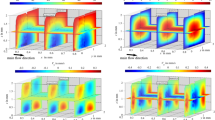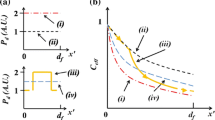Abstract
Temperature of microfluidic system is greatly sensitive because of fast heat conduction and small heat capacity due to the scale effect. The purpose of this study is the development of a measurement system for the temperature field of liquids in a microfluidic device with high spatial- and temporal-resolution. Measurement method employed in this study is laser-induced fluorescence using fluorescein with the temperature dependence of fluorescent intensity. In order to measure the transient temperature field, an image-intensified high-speed camera was utilized. The signal-to-noise ratio can be improved by the time- or phase-averaging scheme. Applying the synchronization mechanism, phase-averaged temperature data with the time resolution of 500 μs can be obtained. Spatial resolution estimated from the Rayleigh limit was approximately 530 nm. The validity of the developed measurement system was confirmed by the experiments for the transient behavior of the liquid temperature undergoing the laser heating in the microfluidic device.
Similar content being viewed by others
References
P. Tabling, Introduction to Microfluidics, Oxford University Press, (2005).
J. H. Knox and K. A. McCormack, Temperature effect in capillary electrophoresis. 1: Internal capillary temperature and effect upon performance, Chromatgraphia, 38(3–4) (1994) 207–214.
E. Grushka, R. M. McCormick and J. J. Kirkland, Effect of temperature gradients on the efficiency of capillary zone electrophoresis separations, Analytical Chemistry, 61(3) (1989) 241–246.
X. Xuan, B. Xu, D. Simon and D. Li, Electroosmotic flow with Joule heating effects, Lab on a Chip, 4(3) (2004) 230–236.
G. Tang, D. Yan, C. Yang, H. Gong, J. C. Chai and Y. C. Lam, Assessment of Joule heating and its effects on electroosmotic flow and electrophoretic transport of solutes in microfluidic channels, Electrophoresis, 27(3) (2006) 628–639.
J. Shimakawa, M. Motosuke and S. Honami, Local microflow control using photothermal viscosity distritbution, Proc. of 6th International Conference on Nanochannels, Microchannels and Minichannels, ICNMM-2008-62207 (2008).
P. B. Bird, W. E. Stewart and E. N. Lightfood, Transport Phenomena 2nd ed., John Wiley & Sons, Inc., (2002).
K. Karstens and K. Kobs, Rhodamine B and rhodamine 101 as reference substance for fluorescence quantum yield measurements, Journal of Physical Chemistry, 84(14) (1980) 1871–1872.
J. R. Lakowicz, Principles of Fluorescence Spectroscopy 3rd ed., Springer, (2006).
R. Matsumoto, H. Farangis Zadeh and P. Ehrard, Quantitative measurement of depth-averaged concentration fields in microchannels by means of a fluorescence intensity method, Experiments in Fluids, 39(4) (2005) 722–729.
D. Ross, M. Gaitan and L. E. Locascio, Temperature measurement in microfluidic systems using a temperature-dependence fluorescent dye, Analytical Chemistry, 73(17) (2001) 4117–4123.
J. G. Santiago, S. T. Wereley, C. D. Beebe and R. J. Adrian, A Particle Image Velocimetry System for Microfluidics, Experiments in Fluids, 25(4) (1998) 316–319.
Author information
Authors and Affiliations
Corresponding author
Additional information
Masahiro Motosuke received his B. S. degree from Department of System Design Engineering at Keio University, Japan, in 2001. He received his M. S. and Ph. D degrees from Keio University in 2003 and 2006. He is now an Assistant Professor at Department of Mechanical Engineering in Tokyo University of Science, Japan. His research interests are in the development of advanced sensing and control for the fluid or particle motion and properties in a microfluidic system based on optical or electrokinetic approach.
Dai Akutsu received his B. S. degree in Mechanical Engineering from Tokyo University of Science, Japan, in 2008. He is currently in the master course of the graduate school of Mechanical Engineering in Tokyo University of Science. His research interests include the temperature measurement of the highly tiny region in a microfluidic device using micro-LIF and the development of micro- mixer/ sorter by means of electrokinetics.
Shinji Honami received his B. S. in Mechanical Engineering from Keio University, Japan, in 1967. He received his M. S. and Ph. D degrees from Keio University in 1969 and 1974, respectively. He is a Professor at School of Engineering, Department of Mechanical Engineering, Tokyo University of Science, Japan. His research interests include turbulent and laminar flow control and microfluidics.
Rights and permissions
About this article
Cite this article
Motosuke, M., Akutsu, D. & Honami, S. Temperature measurement of microfluids with high temporal resolution by laser-induced fluorescence. J Mech Sci Technol 23, 1821–1828 (2009). https://doi.org/10.1007/s12206-009-0609-8
Received:
Revised:
Accepted:
Published:
Issue Date:
DOI: https://doi.org/10.1007/s12206-009-0609-8




